The plant Coleus (Coleus) is a member of the Labiate or Lamb family. This genus unites about 150 species. Its name was formed from the word "kleos", which is translated from Greek as "case". In nature, the species of such a plant can be found in the tropical forests of Africa and Asia. Sometimes inexperienced gardeners call the Coleus "poor man's croton", as its variegated foliage is similar to croton leaves, but it looks less impressive. And this flower is also called "garbage plant", but this is done only by those gardeners who are unfamiliar with the new varieties of Coleus, which are highly decorative. They can compete with both croton and other decorative deciduous plants that are popular in culture. In addition to the fact that Coleus has spectacular foliage, it is very easy to care for it.
Content
Brief description of cultivation
- Bloom... Coleus is cultivated as an ornamental leafy plant.
- Landing... Seeds are sown for seedlings in the last days of March, and seedlings are planted in the soil in the second half of May.
- Illumination... Until midday, the flower needs a lot of bright sunlight, and then it needs a little shading.
- Temperature regime... In the summer it is from 18 to 20 degrees, and in the winter months it is no colder than 12 degrees.
- Watering... Moisten the soil often and abundantly.
- Air humidity... It needs high air humidity, so the bush should be often moistened with a spray bottle, especially on hot days.
- Fertilizer... During the spring-summer period, the flower is fed 1 time in 7 days, and in the winter time - 1 time in 4 weeks. For this, a mineral complex fertilizer is used.
- Pinching... During the growing season, it is carried out systematically.
- Pruning... The bush is pruned after the dormant period ends, at the very beginning of active growth.
- Dormant period... During the winter time.
- Transfer... Regularly once every 3 or 4 years.
- Reproduction... By cuttings and seed method.
- Insect pests... Aphids, whiteflies, mealybugs and spider mites.
- Diseases... Stem and root rot.
Coleus features
The tetrahedral ribbed shoots of Coleus at the base are lignified.Opposite heart-shaped leaf plates are pubescent, they have a serrated edge. In some species, the leaves are small, but among them there are those in which the foliage can reach a length of about 15 centimeters. In natural species, foliage and shoots are outwardly very similar to nettle, in this regard, the people also call the flower "nettle". The color of the leaf plates is a different combination of burgundy, red, green and yellow shades. During flowering, an ear is formed, consisting of small flowers of lilac or blue color, but they do not represent any decorative value. Coleus is grown as an ornamental deciduous plant, however, among the various species and varieties of such a plant, there are also flowering ones.
Growing coleus in the garden
Sowing
Coleus is popular because it is very beautiful and also undemanding to care for. And also because home coleus in the warm season can be grown on your garden plot. This plant can be easily grown from seed, and in specialized stores, if desired, you can find excellent Dutch or English mixtures.
Sowing seeds is recommended in the last days of March. You can sow seeds earlier and later, but in this case, in the cold season, the seedlings will need additional additional lighting. For sowing, a low box is perfect, which is filled with a light soil mixture saturated with nutrients. Distribute the seeds evenly on the surface of the soil mixture and moisten the crops from the sprayer; they do not need to be embedded in the substrate. Cover the seeds with a thin layer of sand on top and cover the box with glass (plastic). Transfer crops to a dark and warm place, make sure that the surface of the substrate in the box is slightly damp all the time. Good commercial seed material is highly germinating, sometimes a sprout emerges from each seed.
The first seedlings should appear just 1–1.5 weeks after sowing. As soon as this happens, remove the shelter and move the box to a well-lit place, protected from direct sunlight, a western or eastern window sill is perfect. The air temperature should be kept between 17 and 19 degrees.


Watch this video on YouTube
Growing seedlings
After the seedlings are 20-30 days old and the first pair of true leaf plates have formed, they will need to pick into special cassettes. Thanks to this, the plants will be able to form a well-developed powerful root system, which will not be damaged during transplantation. Young bushes aged 5 to 6 weeks will require a mandatory transplant into individual 400 g glasses, after which they are pinched so that they grow more bushy.
Transplanting
Seedlings can be planted in open soil only when warm weather sets in, and return frosts are left behind. An area suitable for planting Coleus should be sunny, but in the midday time it should be in a little shade. Also, the flower needs an area that is well protected from gusts of wind. Prepare the planting holes and fill them with a nutrient-rich soil mixture that allows water and air to pass through. Plant seedlings from cups in them.
Planting and growing Coleus is relatively easy, especially if you cultivate it as an annual. If you decide to grow it as a perennial, then keep in mind that after 2 or 3 years the bush will lose its decorative effect, and you will have to grow young plants from cuttings or seeds. And you should also remember that with the onset of autumn, the flowers will have to be dug up, planted in pots and brought into the house, and in the spring they are planted again in the garden.
Plant the seedlings in the prepared area, while the distance between them should not be very large. After that, they are watered abundantly.


Watch this video on YouTube
Caring for Coleus in the garden
In order for the Coleus to grow well in the garden, it must be watered abundantly, especially when there is a hot dry period. For irrigation, it is recommended to use well-settled water, therefore, a volumetric tub or barrel must be installed in the garden area, it can be used to accumulate rainwater or to settle tap water. When the flowers are watered, loosen the surface of the soil around them and pull out all the weeds.
In order for the bushes to grow more lush, during the season they should be slightly trimmed 2 or 3 times. During the growing season, coleus growing in the garden should be systematically fed once every 7 days, using fertilizer with a high nitrogen content for this. Thanks to this, foliage will actively grow and develop, and flowering will be inhibited. As soon as the formation of inflorescences begins, cut them off so that the coleus does not waste its energy on their growth and flowering. In such a simple way, you can grow a lush and spectacular bush of Coleus in the garden.
Coleus at home
How to grow from seeds
Coleus can be grown not only in the garden, but also at home, while it can also be propagated both by cuttings and by seed. Such a flower is grown from seeds in the same way as seedlings for planting in open ground. However, after the seedlings are sorted into separate cassettes, they are then transplanted into individual pots. Further, they begin to look after the bushes in the same way as for adult plants.
Propagation by cuttings
During pruning of an adult bush, the remaining pruning can not be thrown away, but used as cuttings. The length of the cutting should be about 10 centimeters, tear off all leaf plates from its bottom. After that, for rooting, it is planted in moistened sand or substrate, on top of the sections you need to cover the cut with a cut plastic bottle or a transparent bag. Move them to a shaded area and keep them cool (18 to 20 degrees). Rooting takes 1–1.5 weeks, after which the cuttings that have given roots can be planted in a permanent place. It is very easy to propagate Coleus in this way.
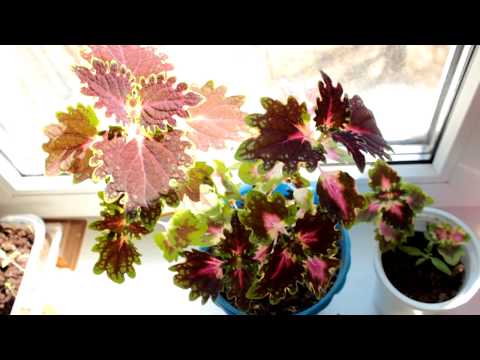

Watch this video on YouTube
Caring for Coleus at home
For the successful cultivation of indoor coleus, it is enough to provide it with the correct watering regime. To do this, it is regularly watered abundantly using soft, well-settled water, the temperature of which should be close to room temperature. Particular attention should be paid to watering in spring and summer. It is necessary to feed the home coleus, like the garden one, once a week during the spring-summer period. To do this, use a complex mineral fertilizer in half the dose recommended by the manufacturer. In the cold season, feeding is carried out 1 time in 30 days.
In spring and summer, it is recommended to systematically moisten the bush from a spray bottle. However, foliage cannot be moistened in direct sunlight. In winter, when the air in the room is dried up by working heating devices, to increase its humidity level, moistened expanded clay is poured into the pallet, and a pot with a plant is placed on it. Timely cut off the inflorescences that have begun to form, they are left only if a decorative flowering species or variety is grown. During the growing season, the bushes will need to be pinched several times, in this case they will be more lush. After the dormant period ends, before the growing season, carry out anti-aging pruning, for this shorten all the stems to 50–70 mm. Experienced florists recommend rooting a few cuttings left after pruning.The fact is that last year's bush may lose its decorative effect.
Diseases and pests
If you do not carry out a timely pinching or pruning of a young Coleus, then its stems will become elongated. Also, a young bush can stretch out due to poor lighting, and it can also happen with an old flower. If the light is too intense, the foliage becomes faded and loses its color. With improper watering, the bush begins to shed foliage. This happens both with excessively poor watering, as well as due to stagnation of liquid in the root system.
Of insects, spider mites, aphids and whiteflies can harm Coleus. Aphids suck sap from the bush, which causes yellowing and shrinking of the affected leaf plates. Also, this pest is considered the main vector of dangerous diseases. To destroy it, the houseplant is sprayed with soapy water. If necessary, after 7 days, the treatment is repeated. Remember that when spraying the bush with a soap solution, the surface of the substrate in the pot must be protected with a film. If aphids settle on garden bushes, they will have to be treated with a solution of a special insecticidal agent, for example, Fitoverma or Aktellika. In order to save Coleus from spider mites, it is sprayed with Apollo, Acarin, Oberon or Agravertin. To combat whitefly, use the same means as for exterminating aphids: Aktara, Aktellik, Oberon and others.
The use of chemicals can greatly harm Coleus, so it is so important to adhere to simple prevention rules. It has long been known that pests bypass healthy and strong plants, so take care of the flower correctly and provide it with suitable conditions for growth.
Coleus in winter
In the garden, Coleus is most often grown as an annual plant. However, if desired, the garden bush can be removed from the ground and planted in a pot, which is brought into the house. In this case, they take care of him in the same way as for the home Coleus. With the onset of autumn, gradually reduce watering, while fertilizing the soil mixture is necessary 1 time in 30 days. The same care should be provided for the home Coleus. Also, during the winter months, the flower should be kept cool (from 8 to 15 degrees).
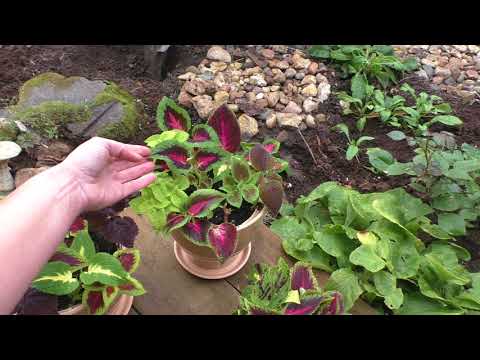

Watch this video on YouTube
Types and varieties of coleus with photos and names
Coleus hybrid (Coleus x hybridus)
This species is most often cultivated at home. It is a small bush, characterized by its unpretentiousness and undemanding care. The bush can reach a height of about 100 cm, the section of the shoots is square. Elongated oval leaf plates have a serrated edge. If the bush grows in a shaded area, then its leaves are colored green. If it is grown in a sunny place, then the color of the leaves will be burgundy.
Coleus rehneltianus
The homeland of this species is Sri Lanka, it is cultivated as an ampelous plant. The stems can reach about half a meter in length. Long-petiolate opposite leaf plates have a wide-heart shape and a wavy edge. The foliage is decorated with veins, which can be painted in various colors, for example: purple, red, yellow, brown, etc.
Coleus blumeii
It is this species that is most popular in culture, as well as its varieties, of which there are quite a few. This plant comes from Southeast Asia. This shrub has stems that reach a height of up to 0.8 m, which lignify at the base over time. Popular varieties:
- Black dragon... Violet-brown leaf plates grooved along the edge are decorated with red veins.
- Wizzard series hybrids... Wizzard Golden has light green foliage, Wizzard Evening Zarya - leaf plates of a fiery red hue have a narrow pale green border, Wizzard Jade - white leaves are decorated with a wide green border.
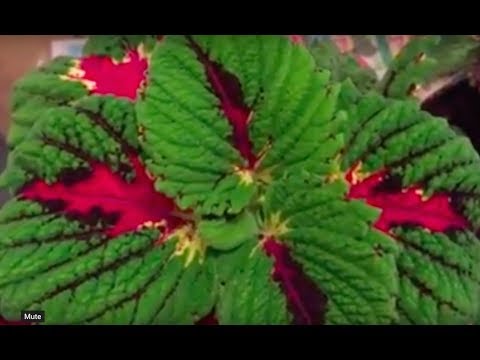

Watch this video on YouTube

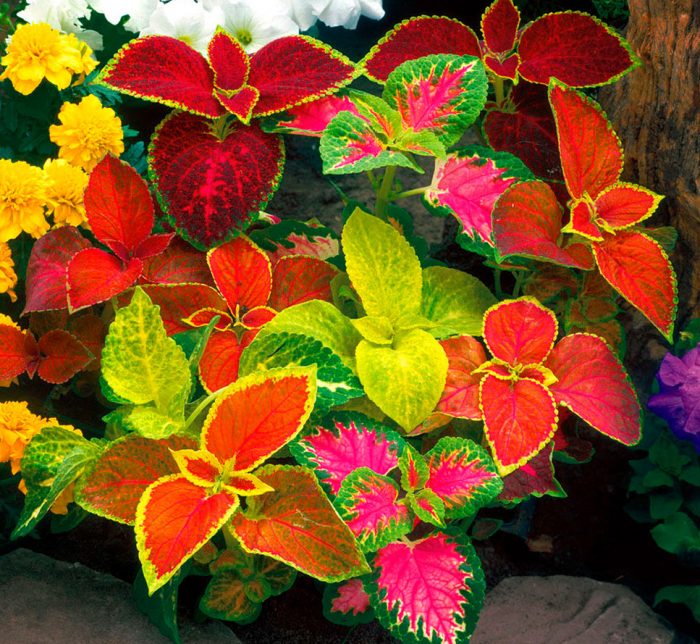
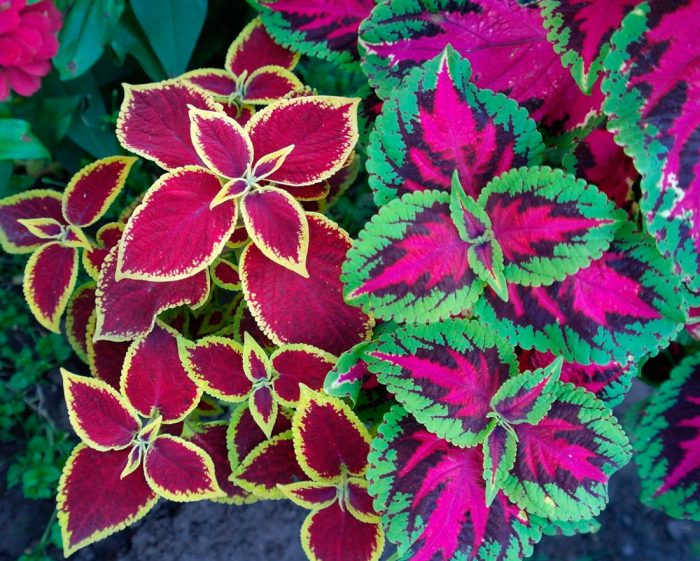
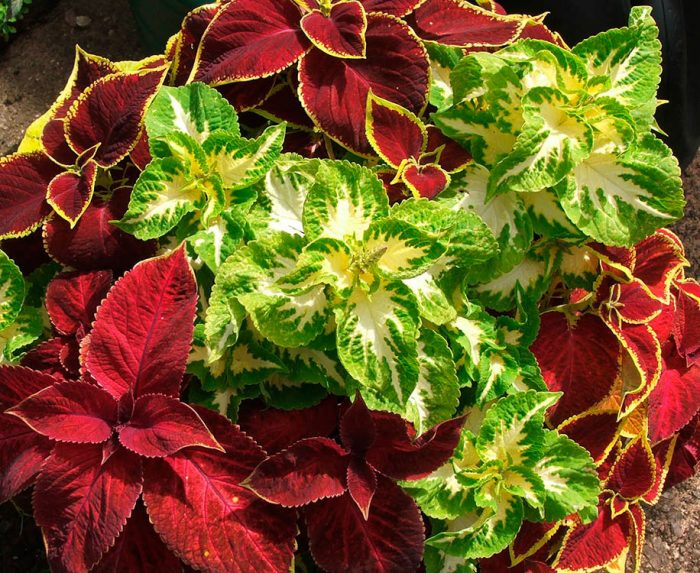
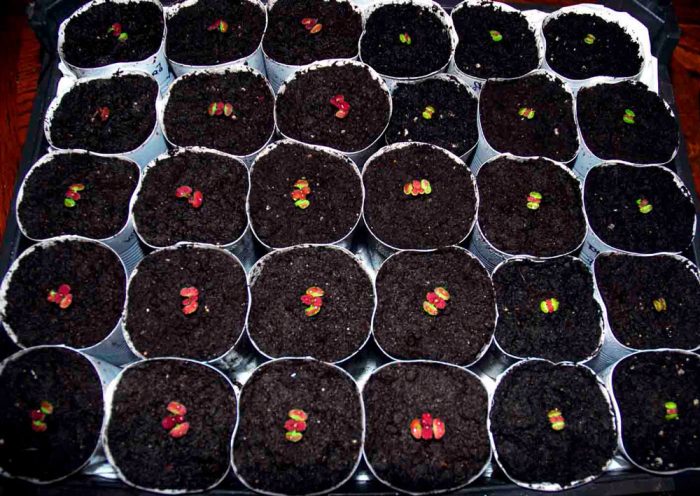
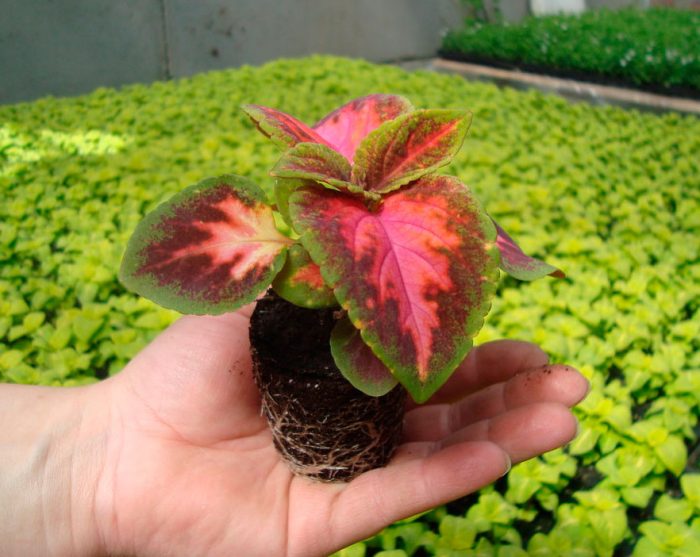

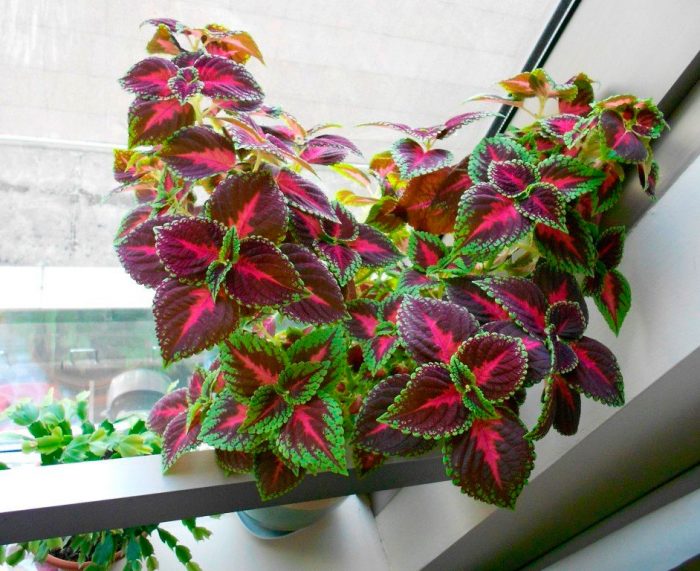
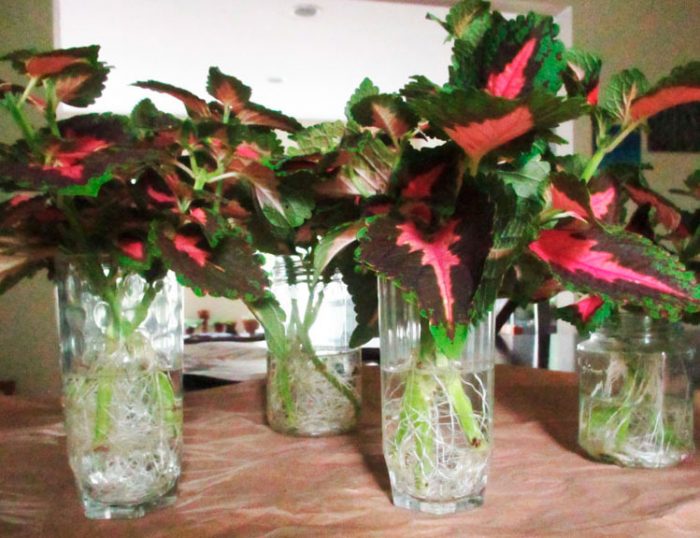
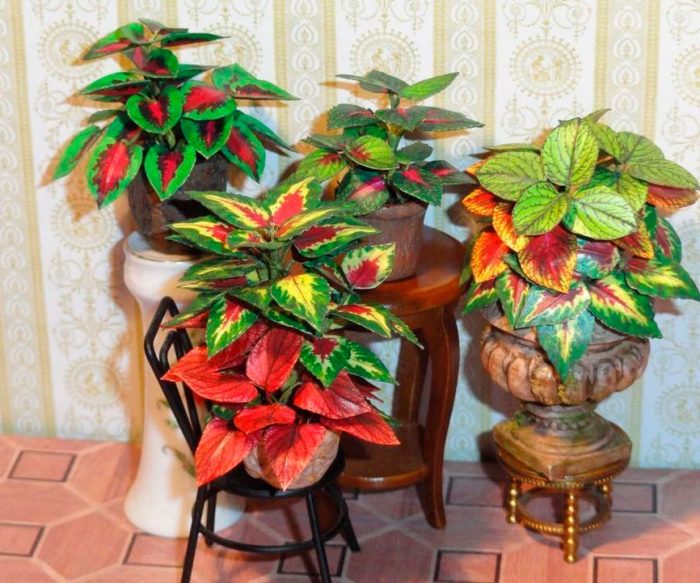
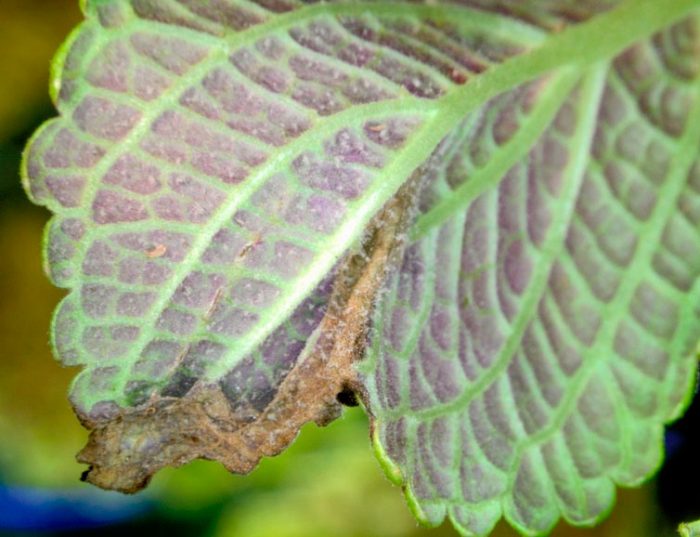
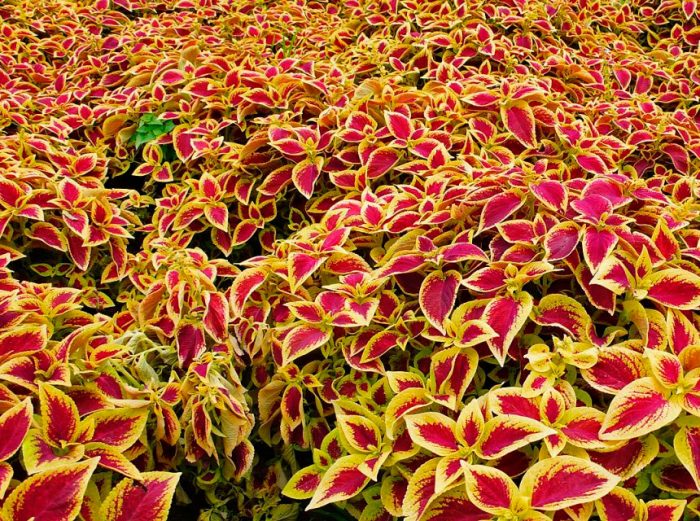
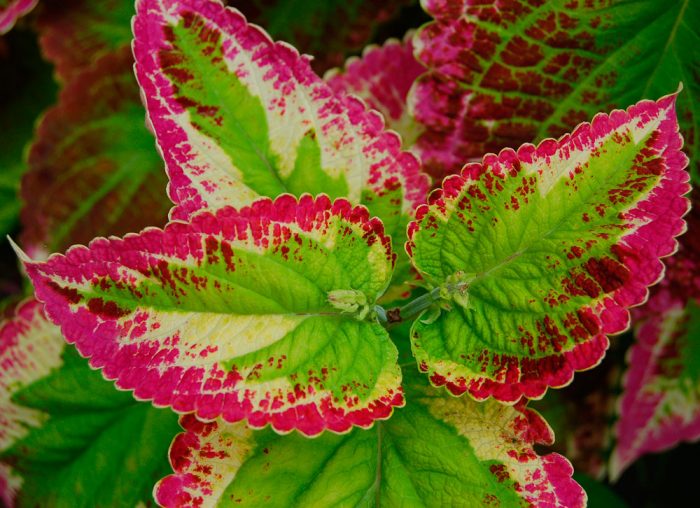
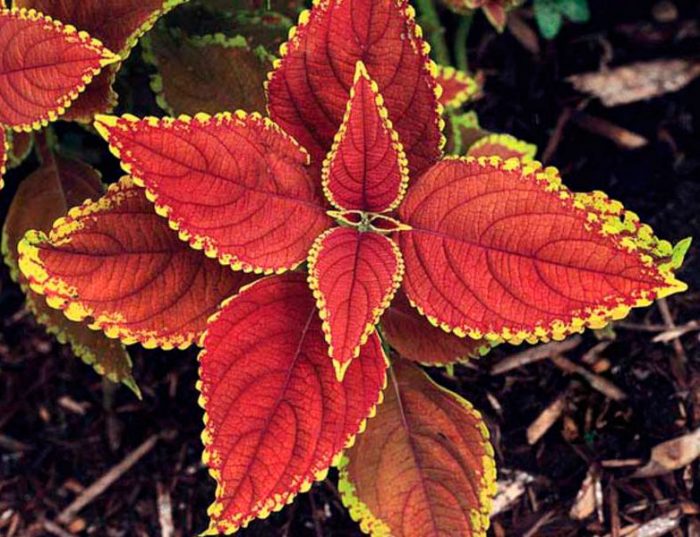
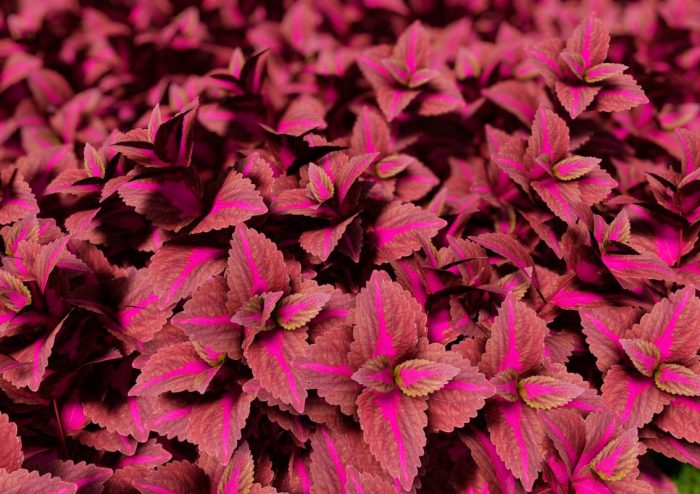











Help, I just planted Coleus yesterday, and someone is already crawling on it !!!